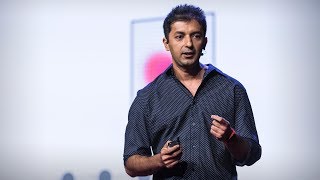Computer algorithms today are performing incredible tasks with high accuracies, at a massive scale, using human-like intelligence.
今天的计算机算法,正在使用类似人类的智能,大规模的执行具有高精度的、不可思议的任务。
And this intelligence of computers is often referred to as AI or artificial intelligence.
而这种计算机智能,通常被称为AI,或“人工智能”。
AI is poised to make an incredible impact on our lives in the future.
人工智能有望在未来对我们的生活产生令人难以置信的影响。
Today, however, we still face massive challenges in detecting and diagnosing several life-threatening illnesses, such as infectious diseases and cancer.
然而今天,在检测和诊断几种危及生命的疾病,比如传染病和癌症时,我们仍然面临着大量的挑战。
Thousands of patients every year lose their lives due to liver and oral cancer.
每年,数以千计的病人因患上肝癌和口腔癌失去生命。
Our best way to help these patients is to perform early detection and diagnoses of these diseases.
帮助病人最好的方式就是对这些疾病进行早期检测和诊断。
So how do we detect these diseases today, and can artificial intelligence help?
那么,今天我们如何检测这些疾病?AI可以提供帮助吗?
In patients who, unfortunately, are suspected of these diseases,
对于不幸被怀疑患有这些疾病的患者,
an expert physician first orders very expensive medical imaging technologies such as fluorescent imaging, CTs, MRIs, to be performed.
专家医师会先要求他们照射非常昂贵的医疗图像,例如荧光成像,CT,MRI等。
Once those images are collected, another expert physician then diagnoses those images and talks to the patient.
收集到这些图像之后,另一位专家医师会进行诊断并与患者交流。
As you can see, this is a very resource-intensive process, requiring both expert physicians, expensive medical imaging technologies,
显而易见,这是个非常耗费资源的过程,需要两位专家医师和昂贵的医学图像技术,
and is not considered practical for the developing world. And in fact, in many industrialized nations, as well.
这在发展中国家被认为并不实用,事实上,在许多工业化国家也是如此。
So, can we solve this problem using artificial intelligence?
那么,我们能够用人工智能解决这个问题吗?
Today, if I were to use traditional artificial intelligence architectures to solve this problem,
今天,如果使用传统的人工智能架构来解决这个问题,
I would require 10,000 -- I repeat, on an order of 10,000 of these very expensive medical images first to be generated.
我可能需要1万张--我重复一次,我首先需要生成1万张这种非常昂贵的医学图像。
After that, I would then go to an expert physician, who would then analyze those images for me.
之后,我会去找一位专业医师为我分析这些图像。
And using those two pieces of information, I can train a standard deep neural network or a deep learning network to provide patient's diagnosis.
利用这两条信息,我可以训练标准的深度神经网络,或深度学习网络对患者进行诊断。
Similar to the first approach, traditional artificial intelligence approaches suffer from the same problem.
与第一步相似,传统人工智能方法遭遇了同样的问题。
Large amounts of data, expert physicians and expert medical imaging technologies.
那就是需要大量的数据、专家医师和专业的医疗图像技术。
So, can we invent more scalable, effective and more valuable artificial intelligence architectures
我们是否能够创造出一种规模更大、更有效率、同时更有价值的人工智能架构,
to solve these very important problems facing us today?
来解决我们今天面临的这些重要的问题呢?
And this is exactly what my group at MIT Media Lab does.
而这就是我们的团队在MIT媒体实验室所研究的内容。
We have invented a variety of unorthodox AI architectures
我们开发了各种新型AI架构,
to solve some of the most important challenges facing us today in medical imaging and clinical trials.
来解决一些我们当今在医疗图像和临床试验中面临的最重要的挑战。
In the example I shared with you today, we had two goals.

Our first goal was to reduce the number of images required to train artificial intelligence algorithms.
第一个目标,是减少用来训练人工智能算法所需要的图片数量。
Our second goal -- we were more ambitious, we wanted to reduce the use of expensive medical imaging technologies to screen patients.
第二个目标--更大的志向,我们希望让患者减少使用昂贵的医疗图像技术。
So how did we do it?
那么我们是怎样做的?
For our first goal, instead of starting with tens and thousands of these very expensive medical images, like traditional AI,
我们的第一个目标,相比于传统AI从成千上万张昂贵的医疗图像开始,
we started with a single medical image. From this image, my team and I figured out a very clever way to extract billions of information packets.
我们选择从单张图像开始。根据这张图片,我和我的团队想出了一种非常聪明的方法来提取数十亿个信息包。
These information packets included colors, pixels, geometry and rendering of the disease on the medical image.
这些信息包包含颜色、像素、形态和疾病呈现在医疗图像上的效果。
In a sense, we converted one image into billions of training data points, massively reducing the amount of data needed for training.
这样一来,我们就将一张图像转换成了数十亿个训练数据点,需要训练的数据量就大大减少了。
For our second goal, to reduce the use of expensive medical imaging technologies to screen patients,
第二个目标,是减少对患者使用医疗图像技术,
we started with a standard, white light photograph, acquired either from a DSLR camera or a mobile phone, for the patient.
最开始,我们会从数码单反相机或手机中获取一张标准的白色光线照片。
Then remember those billions of information packets?
然后,还记得那数十亿个信息包吗?
We overlaid those from the medical image onto this image, creating something that we call a composite image.
将这些医疗图像的信息包覆盖在这张图片上,这时我们就创建了一张合成图像。
Much to our surprise, we only required 50 -- I repeat, only 50 -- of these composite images to train our algorithms to high efficiencies.
令人惊讶的是,我们只需要50张--强调一下,仅仅50张--这些复合图像,就能训练我们的算法提高效率。
To summarize our approach, instead of using 10,000 very expensive medical images,
总结一下我们的方法,区别于用1万张昂贵的医疗图像训练AI算法,
we can now train the AI algorithms in an unorthodox way,
我们使用了一种全新的方式,
using only 50 of these high-resolution, but standard photographs, acquired from DSLR cameras and mobile phones, and provide diagnosis.
只需要将数码相机或手机拍摄的50张高分辨率的标准照片,即可提供诊断。
More importantly, our algorithms can accept, in the future and even right now, some very simple, white light photographs from the patient,
更重要的是,在未来,甚至现在,我们的算法可以接受一些病人自己拍摄的白光照片,
instead of expensive medical imaging technologies.
来替代昂贵的医疗图像技术。
I believe that we are poised to enter an era where artificial intelligence is going to make an incredible impact on our future.
我相信,我们已经准备好进入这样一个时代,人工智能正在对我们的未来产生不可思议的影响。
And I think that thinking about traditional AI, which is data-rich but application-poor,
我也认为相比拥有丰富数据但应用困难的传统AI,
we should also continue thinking about unorthodox artificial intelligence architectures, which can accept small amounts of data
我们应该不断思考非传统的人工智能架构,它们能够接受少量数据,
and solve some of the most important problems facing us today, especially in health care. Thank you very much.
并解决一些今天我们所面临的重要问题,特别是在医疗健康方面。非常感谢。


